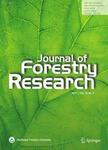Perspectives in restoration: storage and pretreatments of seeds for better germination of Sudanian savanna-woodland species
Perspectives in restoration: storage and pretreatments of seeds for better germination of Sudanian savanna-woodland species作者机构:World Agroforestry Centre (ICRAF) West and Central Africa Regional Office - Sahel Node World Agroforestry Centre & International Crop Research Institute for the Semi-Arid Tropics (ICRAF-ICRISAT) West and Central Africa Region-Sahel Node De'partement Productions Forestie`res Centre National de la Recherche Scientifique et Technologique Institut de l’Environnement et de Recherches Agricoles
出 版 物:《Journal of Forestry Research》 (林业研究(英文版))
年 卷 期:2016年第27卷第4期
页 面:773-778页
核心收录:
基 金:supported by Volkswagen Foundation(Grant Ref:60420897,Dr Patrice Savadogo) CGIAR(Consultative Group on International Agricultural Research)Research Program on Dry lands(CRP 1.1).(Headquarters in Jordan)
主 题:germination restoration plantation ambient mature stored ecology degraded shortened longer
摘 要:Insufficient knowledge of the germination ecology of local species is one of the main constraints to restoration of degraded rural lands. We tested seeds from fourteen Sudanian savanna species targeted for restoration for their response to two different pretreatments(conventional and prolonged acid pretreatments) and two different storage conditions(ambient room conditions and refrigerator at 4 C). For 6 of the studied species, longer soaking in sulphuric acid significantly improved germination rates and also reduced the germination time of some species. Storage condition, in general did not affect germination rates except for two species where cool storage depressed germination. The practical implication is that, for the species tested, when mature seeds are collected for plantation in the upcoming rainy season, there is no need to invest in infrastructure and energy for storing in cold *** study also revealed that in general when seeds are stored in ambient conditions from the time of collection up to seeding time, although germination rate does not increase, germination time is shortened and this could be of great interest in synchronizing germination in real field conditions.




